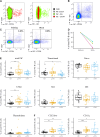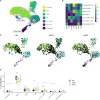Phosphatidylcholine-specific B cells are enriched among atypical CD11chigh and CD21low memory B cells in antiphospholipid syndrome
- PMID: 40529352
- PMCID: PMC12170621
- DOI: 10.3389/fimmu.2025.1585953
Phosphatidylcholine-specific B cells are enriched among atypical CD11chigh and CD21low memory B cells in antiphospholipid syndrome
Abstract
Background: Patients with antiphospholipid syndrome (APS) carry an increased risk of thrombosis and adverse pregnancy outcomes due to the presence of antiphospholipid autoantibodies (aPL). However, the pathogenesis of the disease remains incompletely understood regarding various aPL and the role of autoreactive B cells as precursors of antibody-secreting plasma cells (PC).
Objective: To assess B-cell dysregulation in APS, with a focus on the distribution of B cell subsets and phosphatidylcholine (PtC)-specific cells.
Methods: We used flow cytometry to study B cell subsets in peripheral blood mononuclear cells (PBMCs) from 20 healthy controls (HCs), 21 patients with primary APS (pAPS), and 16 patients with secondary APS (sAPS). A novel fluorescent liposome-based method was used to identify PtC-specific B cells in these subsets. Data were analyzed using manual gating and unsupervised clustering. We quantified aPtC antibody serum levels using ELISA and conducted correlation analyses between PtC-specific B cell subsets and aPL titers.
Results: Patients with pAPS and sAPS exhibited significantly increased frequencies of atypical CD21low and CD11chigh B cells, including PtC-specific B cells. Notably, both total and unswitched memory PtC-specific B cells were elevated in pAPS patients and correlated with aPL antibody titers. Unsupervised clustering further highlighted the increased frequencies of PtC-specific CD21lowCD11chigh unswitched and switched memory B cells in both pAPS and sAPS.
Conclusion: The enrichment of PtC-specific B cells among CD21low and CD11chigh atypical memory subsets, along with their correlation with aPL serum levels, suggest a linkage between these atypical memory B cell subsets and autoantibody producing cells in APS.
Keywords: APS - antiphospholipid syndrome; B cells; adaptive immunity; anti-phospholipid antibodies; antigen-specific B cells; primary APS; secondary APS.
Copyright © 2025 Nitschke, Dang, Rincon-Arevalo, Szelinski, Ritter, Schrezenmeier, Alexander, Le, Chen, Wiedemann, Gonzalez, Lino, Stefanski and Dörner.
Conflict of interest statement
The authors declare that the research was conducted in the absence of any commercial or financial relationships that could be construed as a potential conflict of interest.
Figures





References
-
- Cervera R, Tektonidou MG, Espinosa G, Cabral AR, González EB, Erkan D, et al. Task Force on Catastrophic Antiphospholipid Syndrome (APS) and Non-criteria APS Manifestations (I): catastrophic APS, APS nephropathy and heart valve lesions. Lupus. (2011) 20:165–73. doi: 10.1177/0961203310395051 - DOI - PubMed
MeSH terms
Substances
LinkOut - more resources
Full Text Sources
Research Materials
Miscellaneous

